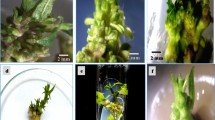Abstract
Somatic embryogenesis was induced in callus tissues derived from young flower buds ofPanax notoginseng via callus within 18 weeks of culture. The mature somatic embryos were germinated on half-strength Murashige and Skoog's (MS) medium supplemented with gibberellic acid A3(GA) and 6-benzyladenine (BA). The most suitable medium for optimal root formation proved to be MS medium supplemented with 1-naphthaleneacetic acid (NAA). Total DNA was extracted from the leaves of the regenerated plantlets ofP. notoginseng. Analysis of random-amplified polymorphic DNA (RAPD) using 21 arbitrary oligonucleotide 10-mers, showed the genetic homogeneity ofP. notoginseng. The amplification products were monomorphic for all of the plantlets ofP. notoginseng regenerated by embryogenesis, suggesting that somatic embryogenesis can be used for clonal micropropagation of this plant.
Similar content being viewed by others
References
Asaka I, Ii I, Hirotani M, Asada Y, Yoshikawa T, Furuya T (1994) Mass production of Ginseng (Panax ginseng) embryoids on media containing high concentration of sugar. Plant Med 60:146–148
Atchison BA, Whitefield PR, Bottomley W (1976) Comparison of chloroplast DNAs by specific fragmentation withEcoRI endonuclease. Mol Gen Genet 148:263–269
Chang WC, Hsing YI (1980a) In vitro flowering of embryoids derived from mature root callus of ginseng (Panax ginseng). Nature 284:341–342
Chang WC, Hsing YI (1980b) Plant regeneration through somatic embryogenesis in root-derived callus of ginseng (Panax ginseng C. A. Meyer). Theor Appl Genet 57:133–135
Choi KT (1988)Panax ginseng C. A. Meyer: micropropagation and the in vitro production of saponins. In: Bajaj YPS (ed) Biotechnology in agriculture and forestry, vol 4: Medicinal and aromatic plants 1. Springer, Berlin Heidelberg New York, pp 484–500
Craig AL, Morrison I, Baird E, Waugh R, Coleman M, Davie P, Fahleson J, Eriksson I, Glimelius K (1994a) Intertribal somatic hybrids betweenBrassica napus andBarbarea vulgaris — production of in vitro plantlets. Plant Cell Rep 13:411–416
Craig AL, Morrison I, Baird E, Waugh R, Coleman M, Davie P, Powell W (1994b) Expression of reducing sugar accumulation in interspecific somatic hybrids of potato. Plant Cell Rep 13:401–405
Fangyuan LI, Xian S, Xichen G (1985) The analysis of the chromosomal morphology and giemsa C-banding pattern in ginseng. Sci Agric Sin 5: 31–35
Fujioka N, Kurisu Y, Miyagawa H, Kohda H, Yamasaki K, Shoyama Y, Nishioka I (1986) Studies on the tissue culture ofPanax japonicus. 1: Multiplication by somatic embryogenesis of flower bud and rhizome. Shoyakugaku Zasshi 40:152–158
Hatano K, Shoyama Y Nishioka I (1988) Clonal multiplication ofAconitum carmichaeli by tip tissue culture and alkaloid contents of clonally propagated plant. Plant Med 54:152–154
Hatano K, Shoyama Y Nishioka I (1989) Clonal propagation ofAtractylodes japonica andA. ovata by tip tissue culture and the atractylon content of clonally propagated plants. Plant Med 56:131–132
Kishira H, Takada M, Shoyama Y (1992) Micropropagation ofPanax ginseng C. A. Meyer by somatic embryos. Acta Hortic 319:197–202
Matsumoto M, Shoyama Y, Nishioka I, Iwai H, Wakimoto S (1989) Identification of viruses infected inRehmannia glutinosa L. var. ‘purpurea’ Makino and effect of virus infection on root yield and iridoid glycoside contents. Plant Cell Rep 7:636–638
Mizukami H, Ohbayashi K, Umetsu K, Hiraoka N (1993a) Restriction fragment length polymorphisms of medicinal plants and crude drugs. II. Analysis ofGlehnia littoralis of different geographical origin. Biol Pharm Bull 16:611–612
Mizukami H, Ohbayashi K, Ohashi H (1993b)Bupleurum falcatum L. in northern Kyushu and Yamaguchi prefecture are genetically distinguished from other populations, based on DNA fingerprints. Biol Pharm Bull 16:729–731
Murashige T, Skoog F (1962) A revised medium for rapid growth and bioassays with tobacco tissue cultures. Physiol Plant 15:473–497
Murray MG, Thompson WF (1980) Rapid isolation of high-molecular-weight plant DNA. Nucleic Acids Res 8: 4321–4325
Nakai R, Shoyama Y, Shiraishi S (1996) Genetic characterization ofEpimedium species using random amplified polymorphic DNA (RAPD) and PCR-restriction fragment length polymorphism (RFLP) diagnosis. Biol Pharm Bull 19:67–70
Narazaki K, Shiraishi S, Watanabe A, Sasaki Y (1996) DNA analysis of the interspecific hybrid clones and the forticultural varieties ofChamaecyparis optusa andChamaecyparis pisifera. J Jpn For Soc 78:157–161
Rani V, Parida A, Raina SN (1995) Random amplified polymorphic DNA (RAPD) markers for genetic analysis in micropropagated plants ofPopulus deltoides Marsh. Plant Cell Rep 14:459–462
Shaw PC, But PPH (1995) Authentication ofPanax species and their adulterants by random-primed polymerase chain reaction. Planta Med 61:466–469
Shoyama Y, Nishioka I, Fujioka N, Kohda H, Yamasaki K (1987) Clonal multiplication ofPanax japonicus by tissue culture. Shoyakugaku Zasshi 41:333–337
Shoyama Y, Kamura K, Nishioka I (1988) Somatic embryogenesis and clonal multiplication ofPanax ginseng. Plant Med 54:155–156
Shoyama Y, Matsushita H, Zhu XX, Kishira H (1995) Somatic embryogenesis in ginseng (Panax species). In: Bajaj YPS (ed) Biotechnology in agriculture and forestry, vol 31: somatic embryogenesis and synthetic seed II. Springer, Berlin Heidelberg New York, pp 344–356
Takemori N, Shinoda K, Kadotani N (1994) RAPD, markers for confirmation of somatic hybrids in the dihaploid breeding of potato (Solarium tuberosum L.). Plant Cell Rep 13:367–371
Tanaka O (1989) Saponin composition ofPanax species. In: Shibata S, Ohtsuka Y, Saito H (eds) Recent advances in ginseng studies. Hirokawa, Tokyo, pp 43–47
Vedel F, Quetier F, Bayen M (1976) Specific cleavage of chloroplast DNA from Niger plants byEcoRI restriction nuclease. Nature 263:440–442
Williams JGK, Kubelik AR, Livak KJ, Rafalski JA, Tingey SV (1990) DNA polymorphisms amplified by arbitrary primers are useful as genetic markers. Nucleic Acids Res 18:6531–6535
Yamada Y, Shoyama Y, Nishioka I (1991) Clonal micropropagation ofGentiana scabra Bunge var. ‘buergeri Maxim’. and examination of the homogeneity concerning the gentiopicroside content. Chem Pharm Bull 39: 204–206
Yamazaki M, Sato A, Shimomura K, Saito K, Murakoshi I (1994) Genetic relationships amongGlycyrrhiza plants determined by RAPD and RFLP analyses. Biol Pharm Bull 17:1529–1531
Author information
Authors and Affiliations
Additional information
Communicated by J. M. Widholm
Rights and permissions
About this article
Cite this article
Shoyama, Y., Zhu, X.X., Nakai, R. et al. Micropropagation ofPanax notoginseng by somatic embryogenesis and RAPD analysis of regenerated plantlets. Plant Cell Reports 16, 450–453 (1997). https://doi.org/10.1007/BF01092764
Received:
Revised:
Accepted:
Issue Date:
DOI: https://doi.org/10.1007/BF01092764




